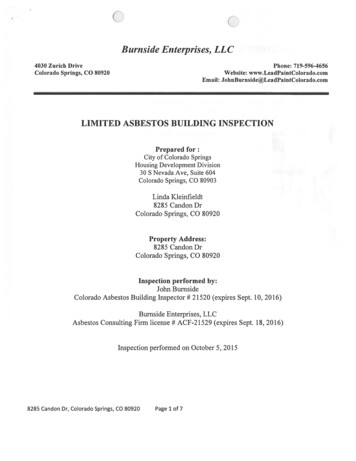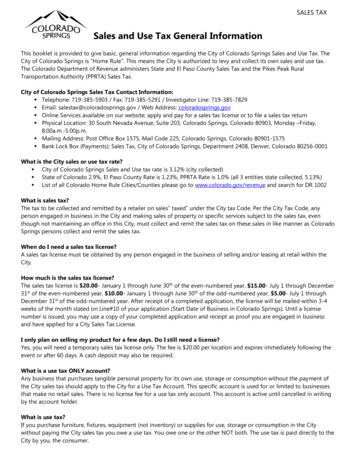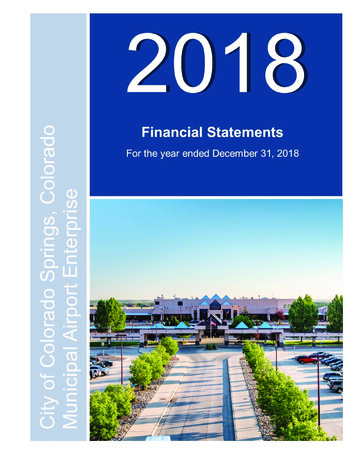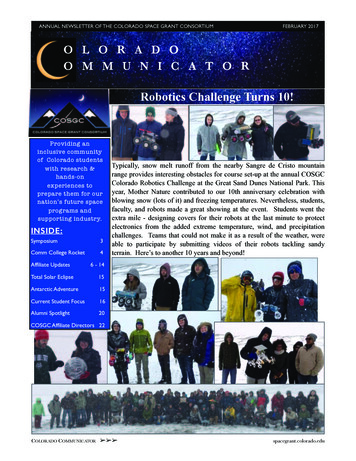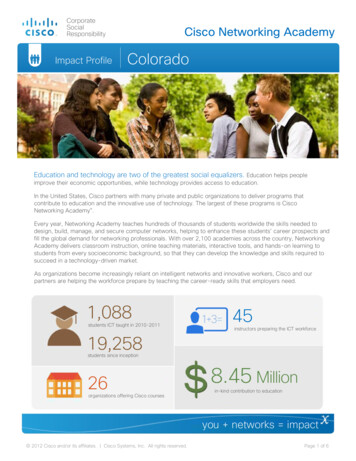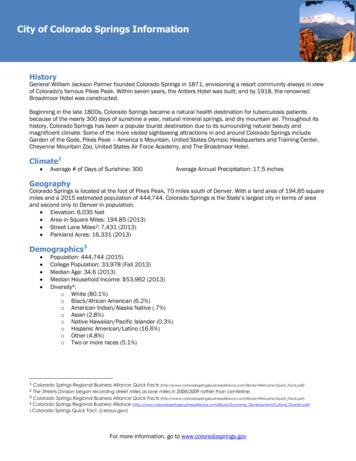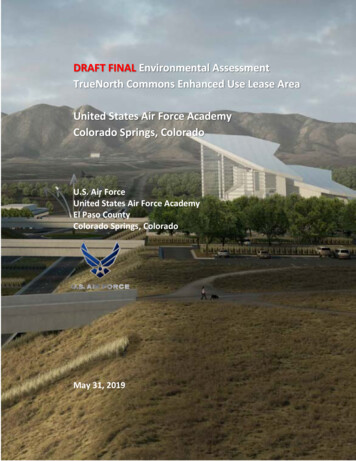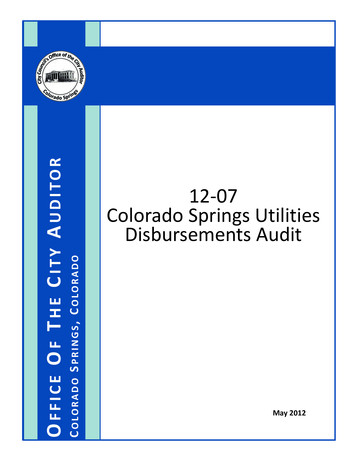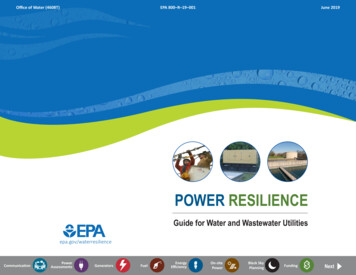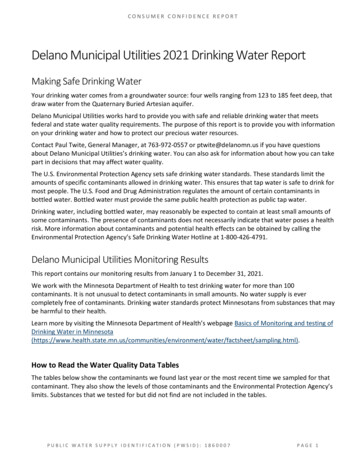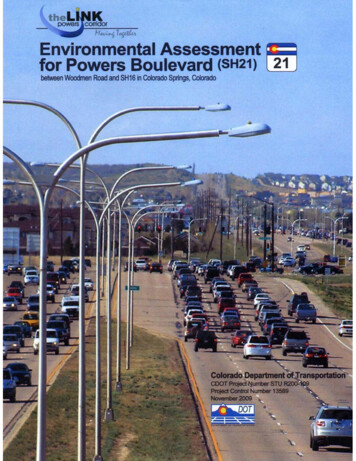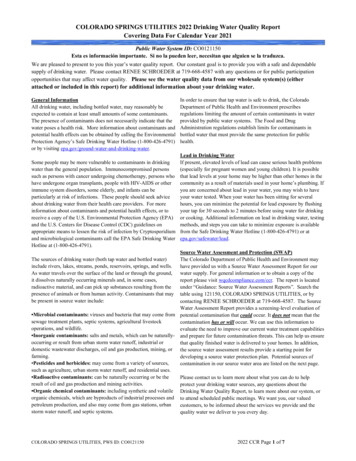
Transcription
COLORADO SPRINGS UTILITIES 2022 Drinking Water Quality ReportCovering Data For Calendar Year 2021Public Water System ID: CO0121150Esta es información importante. Si no la pueden leer, necesitan que alguien se la traduzca.We are pleased to present to you this year’s water quality report. Our constant goal is to provide you with a safe and dependablesupply of drinking water. Please contact RENEE SCHROEDER at 719-668-4587 with any questions or for public participationopportunities that may affect water quality. Please see the water quality data from our wholesale system(s) (eitherattached or included in this report) for additional information about your drinking water.General InformationAll drinking water, including bottled water, may reasonably beexpected to contain at least small amounts of some contaminants.The presence of contaminants does not necessarily indicate that thewater poses a health risk. More information about contaminants andpotential health effects can be obtained by calling the EnvironmentalProtection Agency’s Safe Drinking Water Hotline (1-800-426-4791)or by visiting epa.gov/ground-water-and-drinking-water.Some people may be more vulnerable to contaminants in drinkingwater than the general population. Immunocompromised personssuch as persons with cancer undergoing chemotherapy, persons whohave undergone organ transplants, people with HIV-AIDS or otherimmune system disorders, some elderly, and infants can beparticularly at risk of infections. These people should seek adviceabout drinking water from their health care providers. For moreinformation about contaminants and potential health effects, or toreceive a copy of the U.S. Environmental Protection Agency (EPA)and the U.S. Centers for Disease Control (CDC) guidelines onappropriate means to lessen the risk of infection by Cryptosporidiumand microbiological contaminants call the EPA Safe Drinking WaterHotline at (1-800-426-4791).In order to ensure that tap water is safe to drink, the ColoradoDepartment of Public Health and Environment prescribesregulations limiting the amount of certain contaminants in waterprovided by public water systems. The Food and DrugAdministration regulations establish limits for contaminants inbottled water that must provide the same protection for publichealth.Lead in Drinking WaterIf present, elevated levels of lead can cause serious health problems(especially for pregnant women and young children). It is possiblethat lead levels at your home may be higher than other homes in thecommunity as a result of materials used in your home’s plumbing. Ifyou are concerned about lead in your water, you may wish to haveyour water tested. When your water has been sitting for severalhours, you can minimize the potential for lead exposure by flushingyour tap for 30 seconds to 2 minutes before using water for drinkingor cooking. Additional information on lead in drinking water, testingmethods, and steps you can take to minimize exposure is availablefrom the Safe Drinking Water Hotline (1-800-426-4791) or atepa.gov/safewater/lead.Source Water Assessment and Protection (SWAP)The Colorado Department of Public Health and Environment mayhave provided us with a Source Water Assessment Report for ourwater supply. For general information or to obtain a copy of thereport please visit wqcdcompliance.com/ccr. The report is locatedunder “Guidance: Source Water Assessment Reports”. Search thetable using 121150, COLORADO SPRINGS UTILITIES, or bycontacting RENEE SCHROEDER at 719-668-4587. The SourceWater Assessment Report provides a screening-level evaluation of Microbial contaminants: viruses and bacteria that may come from potential contamination that could occur. It does not mean that thesewage treatment plants, septic systems, agricultural livestockcontamination has or will occur. We can use this information tooperations, and wildlife.evaluate the need to improve our current water treatment capabilities Inorganic contaminants: salts and metals, which can be naturally- and prepare for future contamination threats. This can help us ensureoccurring or result from urban storm water runoff, industrial orthat quality finished water is delivered to your homes. In addition,domestic wastewater discharges, oil and gas production, mining, or the source water assessment results provide a starting point forfarming.developing a source water protection plan. Potential sources of Pesticides and herbicides: may come from a variety of sources,contamination in our source water area are listed on the next page.such as agriculture, urban storm water runoff, and residential uses. Radioactive contaminants: can be naturally occurring or be thePlease contact us to learn more about what you can do to helpresult of oil and gas production and mining activities.protect your drinking water sources, any questions about the Organic chemical contaminants: including synthetic and volatile Drinking Water Quality Report, to learn more about our system, ororganic chemicals, which are byproducts of industrial processes and to attend scheduled public meetings. We want you, our valuedpetroleum production, and also may come from gas stations, urbancustomers, to be informed about the services we provide and thestorm water runoff, and septic systems.quality water we deliver to you every day.The sources of drinking water (both tap water and bottled water)include rivers, lakes, streams, ponds, reservoirs, springs, and wells.As water travels over the surface of the land or through the ground,it dissolves naturally occurring minerals and, in some cases,radioactive material, and can pick up substances resulting from thepresence of animals or from human activity. Contaminants that maybe present in source water include:COLORADO SPRINGS UTILITIES, PWS ID: CO01211502022 CCR Page 1 of 7
Our Water SourcesSources (Water Type - Source Type)INTAKE MONUMENT CREEK PIKEVIEW RESERVOIR (SurfaceWater-Intake)INTAKE PUEBLO RESERVOIR DAM C (Surface Water-Intake)INTAKE NORTH CATAMOUNT RESERVOIR DAM (SurfaceWater-Intake)INTAKE SOUTH CATAMOUNT RESERVOIR DAM (SurfaceWater-Intake)INTAKE NORTH AND SOUTH CASCADE CREEK (SurfaceWater-Intake)INTAKE FRENCH CREEK (Surface Water-Intake)INTAKE WEST MONUMENT CREEK (Surface Water-Intake)INTAKE RESERVOIR BIG TOOTH DAM (Surface Water-Intake)INTAKE LION CREEK (Surface Water-Intake)INTAKE SHEEP CREEK (Surface Water-Intake)INTAKE CABIN CREEK (Surface Water-Intake)INTAKE MANITOU 1 (Surface Water-Intake)INTAKE GOLD CAMP RESERVOIR DAM (Surface Water-Intake)INTAKE SOUTH SUBURBAN DAM CREEK (Surface WaterIntake)INTAKE RAMPART RESERVOIR (Surface Water-Intake)INTAKE RUXTON CREEK (Surface Water-Intake)INTAKE LAKE MORAINE DAM CREST (Surface Water-Intake)INTAKE CRYSTAL RESERVOIR DAM (Surface Water-Intake)INTAKE ROSEMONT RESERVOIR (Surface Water-Intake)INTAKE N AND S CHEYENNE CREEK (Surface Water-Intake)INTAKE BLUE RIVER SYSTEM (Surface Water-Intake)INTAKE PIKEVIEW RESERVOIR (Surface Water-Intake)PURCHASED FROM FOUNTAIN VALLEY 121300 (SurfaceWater-Consecutive Connection)INTAKE HOMESTAKE AND FRY ARKANSAS (Surface WaterIntake)INTAKE N AND S SLOPE RSVR FOUNTAIN C (Surface WaterIntake)INTAKE NORTHFIELD RSVR (Surface Water-Intake)INTAKE RAMPART RSVR W MONUMENT CRK (Surface WaterIntake)INTAKE PUEBLO RESERVOIR FOR SDS WTP (Surface WaterIntake)Potential Source(s) of ContaminationEPA Superfund Sites, EPA Abandoned Contaminated Sites, EPAHazardous Waste Generators, EPA Chemical Inventory/StorageSites, EPA Toxic Release Inventory Sites, Permitted WastewaterDischarge Sites, Aboveground, Underground and LeakingStorage Tank Sites, Solid Waste Sites, Existing/Abandoned MineSites, Concentrated Animal Feeding Operations, Other Facilities,Commercial/Industrial/Transportation, High IntensityResidential, Low Intensity Residential, Urban RecreationalGrasses, Quarries / Strip Mines / Gravel Pits, Row Crops, Fallow,Small Grains, Pasture / Hay, Deciduous Forest, Evergreen Forest,Mixed Forest, Septic Systems, Oil / Gas Wells, Road MilesTerms and Abbreviations Maximum Contaminant Level (MCL) The highest level of a contaminant allowed in drinking water. Treatment Technique (TT) A required process intended to reduce the level of a contaminant in drinking water. Health-Based A violation of either a MCL or TT. Non-Health-Based A violation that is not a MCL or TT. Action Level (AL) The concentration of a contaminant which, if exceeded, triggers treatment and other regulatoryrequirements. Maximum Residual Disinfectant Level (MRDL) The highest level of a disinfectant allowed in drinking water. Thereis convincing evidence that addition of a disinfectant is necessary for control of microbial contaminants. Maximum Contaminant Level Goal (MCLG) The level of a contaminant in drinking water below which there is noknown or expected risk to health. MCLGs allow for a margin of safety.COLORADO SPRINGS UTILITIES, PWS ID: CO01211502022 CCR Page 2 of 7
Maximum Residual Disinfectant Level Goal (MRDLG) The level of a drinking water disinfectant, below which thereis no known or expected risk to health. MRDLGs do not reflect the benefits of the use of disinfectants to control microbialcontaminants. Violation (No Abbreviation) Failure to meet a Colorado Primary Drinking Water Regulation. Formal Enforcement Action (No Abbreviation) Escalated action taken by the State (due to the risk to public health, ornumber or severity of violations) to bring a non-compliant water system back into compliance. Variance and Exemptions (V/E) Department permission not to meet a MCL or treatment technique under certainconditions. Gross Alpha (No Abbreviation) Gross alpha particle activity compliance value. It includes radium-226, but excludesradon 222, and uranium. Picocuries per liter (pCi/L) Measure of the radioactivity in water. Nephelometric Turbidity Unit (NTU) Measure of the clarity or cloudiness of water. Turbidity in excess of 5 NTU isjust noticeable to the typical person. Compliance Value (No Abbreviation) – Single or calculated value used to determine if regulatory contaminant level(e.g. MCL) is met. Examples of calculated values are the 90th Percentile, Running Annual Average (RAA) and LocationalRunning Annual Average (LRAA). Average (x-bar) Typical value. Range (R) Lowest value to the highest value. Sample Size (n) Number or count of values (i.e. number of water samples collected). Parts per million Milligrams per liter (ppm mg/L) One part per million corresponds to one minute in two years ora single penny in 10,000. Parts per billion Micrograms per liter (ppb ug/L) One part per billion corresponds to one minute in 2,000 years,or a single penny in 10,000,000. Not Applicable (N/A) – Does not apply or not available. Level 1 Assessment – A study of the water system to identify potential problems and determine (if possible) why totalcoliform bacteria have been found in our water system. Level 2 Assessment – A very detailed study of the water system to identify potential problems and determine (if possible)why an E. coli MCL violation has occurred and/or why total coliform bacteria have been found in our water system onmultiple occasions.Detected ContaminantsCOLORADO SPRINGS UTILITIES routinely monitors for contaminants in your drinking water according to Federal and Statelaws. The following table(s) show all detections found in the period of January 1 to December 31, 2021 unless otherwise noted. TheState of Colorado requires us to monitor for certain contaminants less than once per year because the concentrations of thesecontaminants are not expected to vary significantly from year to year, or the system is not considered vulnerable to this type ofcontamination. Therefore, some of our data, though representative, may be more than one year old. Violations and FormalEnforcement Actions, if any, are reported in the next section of this report.Note: Only detected contaminants sampled within the last 5 years appear in this report. If no tables appear in this section then nocontaminants were detected in the last round of monitoring.Disinfectants Sampled in the Distribution SystemTT Requirement: At least 95% of samples per period (month or quarter) must be at least 0.2 ppm ORIf sample size is less than 40 no more than 1 sample is below 0.2 ppmTypical Sources: Water additive used to control microbesDisinfectantNameTime PeriodResultsNumber of SamplesBelow LevelSampleSizeTTViolationMRDLChlorineDecember, 2021Lowest period percentage of samplesmeeting TT requirement: 100%0238No4.0 ppmCOLORADO SPRINGS UTILITIES, PWS ID: CO01211502022 CCR Page 3 of 7
Lead and Copper Sampled in the Distribution eSizeUnit centileALExceedanceTypical Corrosion ofhousehold plumbingsystems; Erosion ofnatural rosion ofhousehold plumbingsystems; Erosion ofnatural depositsDisinfection Byproducts Sampled in the Distribution SystemNameYearAverageRangeLow – HighSampleSizeUnit ofMeasureMCLMCLGMCLViolationTypical SourcesTotalHaloaceticAcids(HAA5)202132.29.21 to 54.248ppb60N/ANoByproduct of drinkingwater 7 to 61.748ppb80N/ANoByproduct of drinkingwater disinfectionTotal Organic Carbon (Disinfection Byproducts Precursor) Removal Ratio of Raw and Finished WaterContaminantNameYearAverageRangeLow – HighSampleSizeUnit ofMeasureTT MinimumRatioTTViolationTypical SourcesTotal OrganicCarbon Ratio20211.261 to 1.7515Ratio1.00NoNaturally presentin theenvironment*If minimum ratio not met and no violation identified then the system achieved compliance using alternative criteria.Summary of Turbidity Sampled at the Entry Point to the Distribution SystemContaminantNameSampleDateLevel FoundCOLORADO SPRINGS UTILITIES, PWS ID: CO0121150TT RequirementTTViolation2022 CCR Page 4 of 7TypicalSources
Summary of Turbidity Sampled at the Entry Point to the Distribution SystemContaminantNameSampleDateLevel FoundTT Month:MarHighest single measurement:0.596 NTUMaximum 1 NTU for any singlemeasurementNoSoil RunoffTurbidityMonth:DecLowest monthly percentage ofsamples meeting TT requirementfor our technology: 100 %In any month, at least 95% ofsamples must be less than 0.3NTUNoSoil RunoffRadionuclides Sampled at the Entry Point to the Distribution SystemContaminantNameYearAverageRangeLow – HighSampleSizeUnit ofMeasureMCLMCLGMCLViolationTypical SourcesGross Alpha20200.320 to 1.025pCi/L150NoErosion ofnatural depositsCombinedRadium20201.20 to 1.95pCi/L50NoErosion ofnatural depositsCombinedUranium20200.80 to 45ppb300NoErosion ofnatural depositsInorganic Contaminants Sampled at the Entry Point to the Distribution SystemContaminantNameYearAverageRangeLow – HighSampleSizeUnit ofMeasureMCLMCLGMCLViolationTypical SourcesBarium20210.020.01 to 0.055ppm22NoDischarge ofdrilling wastes;discharge frommetal refineries;erosion of naturaldepositsFluoride20210.520.14 to 1.545ppm44NoErosion of naturaldeposits; wateradditive whichpromotes strongteeth; dischargefrom fertilizer andaluminumfactoriesNitrate202100 to 05ppm1010NoRunoff fromfertilizer use;leaching fromseptic tanks,sewage; erosion ofnatural depositsSelenium20210.880 to 4.45ppb5050NoDischarge frompetroleum andCOLORADO SPRINGS UTILITIES, PWS ID: CO01211502022 CCR Page 5 of 7
Inorganic Contaminants Sampled at the Entry Point to the Distribution SystemContaminantNameYearAverageRangeLow – HighSampleSizeUnit ofMeasureMCLMCLGMCLViolationTypical Sourcesmetal refineries;erosion of naturaldeposits; dischargefrom minesVolatile Organic Contaminants Sampled at the Entry Point to the Distribution SystemContaminantNameYearAverageRangeLow – HighSampleSizeUnit ofMeasureMCLMCLGMCLViolationTypical SourcesXylenes20210.40 to 1.57ppb10,00010,000NoDischarge frompetroleumfactories;discharge fromchemical factoriesSecondary Contaminants****Secondary standards are non-enforceable guidelines for contaminants that may cause cosmetic effects (such as skin, or toothdiscoloration) or aesthetic effects (such as taste, odor, or color) in drinking water.ContaminantNameYearAverageRangeLow – HighSampleSizeUnit ofMeasureSecondary StandardSodium202111.537.08 to 25.25ppmN/ACHLORINE20190.540.15 to 0.88214MG/LUnregulated Contaminants***EPA has implemented the Unregulated Contaminant Monitoring Rule (UCMR) to collect data for contaminants that are suspected to bepresent in drinking water and do not have health-based standards set under the Safe Drinking Water Act. EPA uses the results of UCMRmonitoring to learn about the occurrence of unregulated contaminants in drinking water and to decide whether or not these contaminantswill be regulated in the future. We performed monitoring and reported the analytical results of the monitoring to EPA in accordance withits Unregulated Contaminant Monitoring Rule (UCMR). Once EPA reviews the submitted results, the results are made available in theEPA’s National Contaminant Occurrence Database (NCOD) tabase-ncod)Consumers can review UCMR results by accessing the NCOD. Contaminants that were detected during our UCMR sampling and thecorresponding analytical results are provided below.Contaminant NameYearAverageCOLORADO SPRINGS UTILITIES, PWS ID: CO0121150RangeLow – HighSample SizeUnit of Measure2022 CCR Page 6 of 7
Unregulated Contaminants***EPA has implemented the Unregulated Contaminant Monitoring Rule (UCMR) to collect data for contaminants that are suspected to bepresent in drinking water and do not have health-based standards set under the Safe Drinking Water Act. EPA uses the results of UCMRmonitoring to learn about the occurrence of unregulated contaminants in drinking water and to decide whether or not these contaminantswill be regulated in the future. We performed monitoring and reported the analytical results of the monitoring to EPA in accordance withits Unregulated Contaminant Monitoring Rule (UCMR). Once EPA reviews the submitted results, the results are made available in theEPA’s National Contaminant Occurrence Database (NCOD) tabase-ncod)Consumers can review UCMR results by accessing the NCOD. Contaminants that were detected during our UCMR sampling and thecorresponding analytical results are provided below.Contaminant NameYearAverageRangeLow – HighSample SizeUnit of Measure***More information about the contaminants that were included in UCMR monitoring can be found at: ed-Contaminant-Monitoring-Rule-UCMR. Learn more about the EPA UCMR at: monitoring-rule or contact the Safe Drinking Water Hotline at (800) 426-4791 or epa.gov/ground-waterand-drinking-water.Violations, Significant Deficiencies, and Formal Enforcement ActionsNo Violations or Formal Enforcement ActionsCOLORADO SPRINGS UTILITIES, PWS ID: CO01211502022 CCR Page 7 of 7
COLORADO SPRINGS UTILITIES, PWS ID: CO0121150 2022 CCR Page 1 of 7. COLORADO SPRINGS UTILITIES 2022 Drinking Water Quality Report Covering Data For Calendar Year 2021. Public Water System ID: CO0121150. Esta es información importante. Si no la pueden leer, necesitan que alguien se la traduzca.
